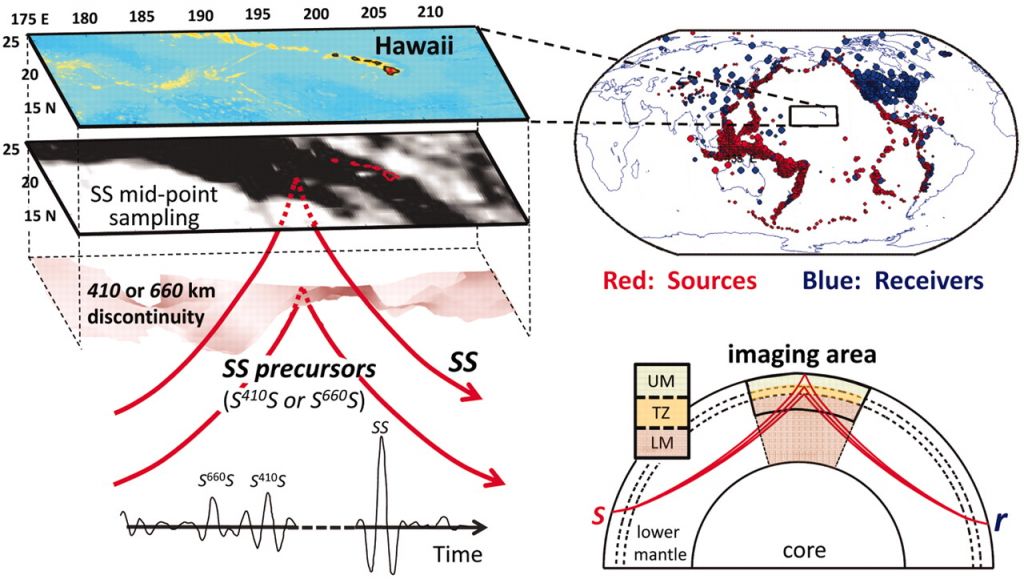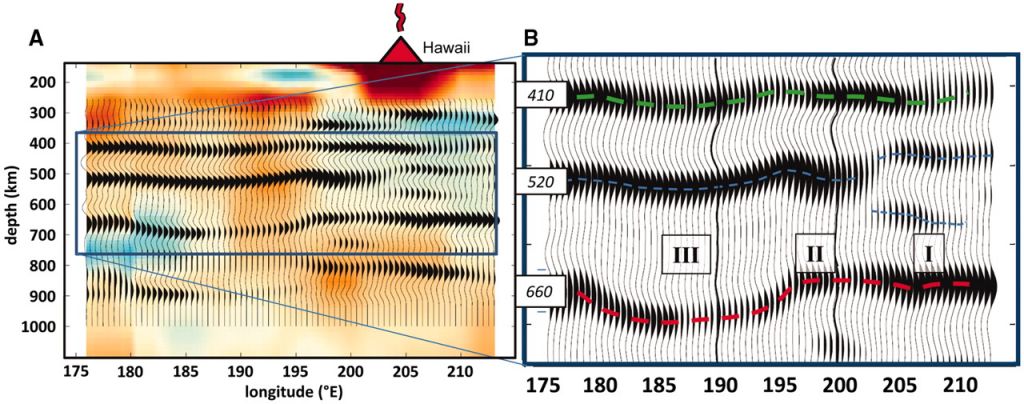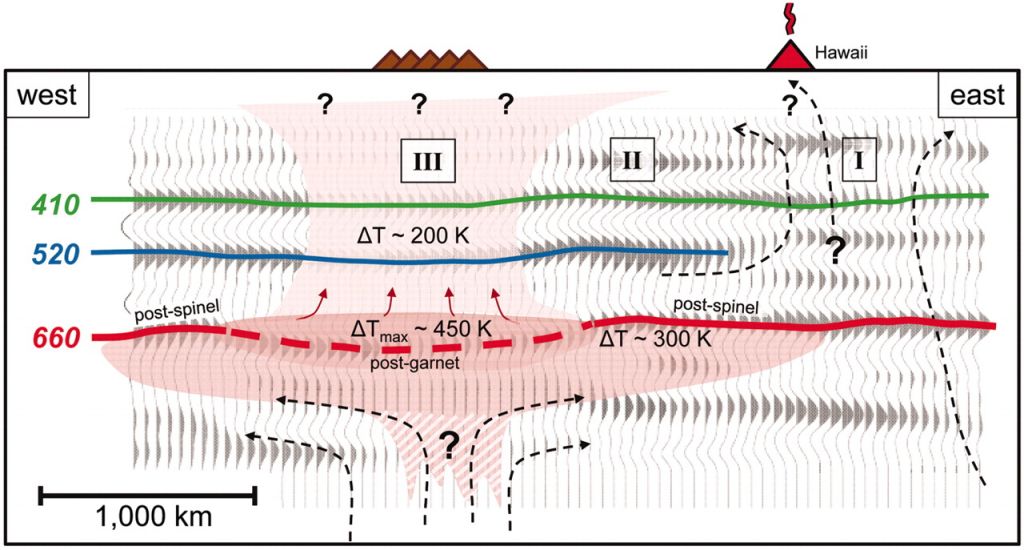博文
地幔转换带不连续面地震成像结果指示夏威夷西部存在热地幔
|||
地幔转换带不连续面地震成像结果指示夏威夷西部存在热地幔
Seismic imaging of transition zone discontinuities suggests hot mantle west of Hawaii
Q. Cao1,*, R. D. van der Hilst1,*, M. V. de Hoop2, and S.-H. Shim1
太平洋中部夏威夷热点通常都被认为是来自深部地幔物质穿越上地幔在地表形成的,但是要在地震学上对plume进行严格的约束却是比较困难的事情。来自美国麻省理工大学(MIT)的van der Hilst研究小组(http://quake.mit.edu/hilstgroup/robspage/),通过地球物理方法,对夏威夷周围地区地幔转换带的结构(不连续面深度,转换带厚度)进行了研究,并对转换带边界的异常进行了讨论分析,他们认为这些异常是由于高温条件下的地幔矿物相变(橄榄石和石榴石体系相变)形成的,但是这些热物质并不是来自于下地幔,这与传统地球化学研究观点是不同的。这一研究成果发表在2011年5月27日最新一期Science杂志上。
(延伸阅读):Hawaii heat source debated:http://www.sciencenews.org/view/generic/id/74845/title/Hawaii_heat_source_debated
Science原文链接:http://www.sciencemag.org/content/332/6033/1068.full
Supporting Online Material:www.sciencemag.org/cgi/content/full/332/6033/1068/DC1
PDF文档:http://quake.mit.edu/hilstgroup/robspage/PapersPDF/2011Science_Hawaii_I.pdf
全文翻译:周春银
夏威夷热点(hotspot)通常被认为是由来自地幔深部的热物质形成的,但是要通过地震学方法来探测这样一个热柱却是很困难的。为了研究这样的热异常,我们利用SS波逆散射方法对太平洋中部之下的地震不连续面进行了成像,这些不连续面我们可以用地幔岩成分的地幔中的橄榄石和石榴石的相变来解释。在夏威夷西部地幔转换带中出现的800-2000 km的热异常(ΔTmax~300-400 K),说明这些热物质并不是从下地幔通过较细的垂直热柱(plume)上升上来的,而是在其进入流向夏威夷或者其他岛屿地区的热流之前就已堆积在转换带底部。这说明夏威夷熔岩的地球化学特征并不能直接约束下地幔(地球化学)域。
地幔柱(mantle plume)仍然是地球深部研究(studies of Earth’s deep interior, SEDI)中尚未完全解决的问题,作为与地幔柱有关的热点活动的原型,夏威夷长期以来都是争论的焦点。在运动的太平洋板块下面有一个来自下地幔的细细的热柱(1-5),这样的经典观点已经被广泛运用于夏威夷熔岩(6-7)、地幔柱-板块相互作用(8)以及对流地幔风对地幔柱形态和海山链发育的影响作用(9,10)等方面的研究。深源地幔柱的经典一直都受到质疑,但是,仍有一些其他的代表性的解释,如来自转换带底部附近热边界处的上升流(11)和浅部地幔过程(12)。有关传说中的地幔柱的存在、定位和起源深度的层析成像证据仍然是比较模糊的(13-17)(SOM text 1)。
与深源地幔柱相关的温度异常会影响到矿物相边界(压力引起的)的深度,这可以通过地震波的反射或转换来确定(18)。非常重要的成像目标为在410km和660km深度附近(Mg,Fe)2SiO4体系的橄榄石-瓦兹利石相变和后尖晶石相变(19)。由于他们具有相反的克拉伯龙斜率(Clapeyron slope),高温将会使前者下降而使后者抬升(SOM text 2)。接收函数方法研究(P-S转换)显示在夏威夷西南部(20-22)以及夏威夷岛链(23)之下存在较薄的地幔转换带。这表明存在高温环境,但是这些异常在侧向上的范围还难于确定,因为在岛屿及其周围地区地震台网还不够。
在超出接收函数方法之外,转换带不连续面可以利用下面的SdS反射(d是反射深度)来成像确定,它在远离研究区域之外作为接收器面反射SS波的前驱波(precursors)而到达(Fig.1)。传统方法通过沿大范围(10º-20º)区域叠加镜像(像镜子一样)SS反射来提高较弱的信号(24-28)。这样的平均化会导致较低的空间分辨率,但是还并未得到夏威夷之下明显的410和660km不连续面(SOM text 1)。本文我们使用了SS波场的三维(3D)逆散射方法,以及被称为GRT(generalized Radon transform)(29)(SOM text 3)的方法(改自碳氢化合物勘探方法)。这也会产生数据冗余,但是不再在立体空间(bins)内叠加静态相,它结合了与单一成像点散射波相关的信号。利用SS前驱波进行GRT成像的可行性最早是在一个远离已知的热上涌和下降的大洋区域得到证明的(30)。

Fig. 1 Left: (Top) Map of study region (175° to 214°E; 12° to 26°N; Mercator projection, perspective view); (middle) geographical distribution of ~170,000 surface mid-points of SS waves (the darker the shading, the denser the coverage (SOM text 3.2); (bottom) path geometry of underside reflections at the surface (SS) and an upper-mantle discontinuity (S410S or S660S); precursor stack showing signal associated with S660S, S410S, and SS waves [after (27)]. Right: (Top) Geographical distribution of ~4800 sources (red symbols) and ~2250 receivers (blue) from which data are used, and which produces the data coverage shown on the left; (bottom) schematic view of ray geometry of SS, S410S, and S660S sampling the upper-mantle transition zone below the imaging area (UM, upper mantle; TZ, transition zone; LM, lower mantle).
我们利用SS波场~170000宽频带(20-50s)记录来对夏威夷及其附近区域的转换带进行成像,这些记录来自于太平洋地区附近总共~2250地震台站~4800次地震记录(震级mb>5.2,震源深度<75km)(Fig.1, SOM text 3.1)。数据覆盖在大多数研究区域都是足够的,但是向西南方向会降低(SOM fig.S6, C and F)。在250-950 km深度范围、0.5º×0.5º经纬度格子内GRT得到弹性差异的1D剖面(SOM text 3.2 and 3.3)。这些图像,经过3D地幔不均一性(利用不同的层析成像模型)和SS反射点深度区域变化的校正,可以在与接收函数方法相当的辐射分辨率条件下确定边界。这些紧密隔开的反射剖面显示了410km和660km不连续面的深度变化(topography),并阐明了在其他深度可能会被当作噪声而处理的构造。我们利用抽样分析来了解这些成像结果的可靠性(SOM text 3.5)。
3D成像的横截剖面如穿过夏威夷的剖面(Fig.2)显示了多个散射水平面。除了410km附近和650-700km深度范围内的反射体之外,在大约350、500、550以及800-900km深度附近也有散射产生。大多数都是连续的并具有明显的topography,但是有些仍然是断断续续的或者分散的。我们这里主要关注转换带的通常边界。在Fig.2B中我们追踪横截剖面中的410km和660km不连续面,从所有网格点选取的深度得出不连续面深度(Fig.3A and B)、转换带厚度(Fig.3C)和深度相关性(Fig.3D)图像。

Fig. 2 Seismic section (E-W) across Hawaii (see Fig. 3 for section location). (A) Seismic image superimposed on tomographically inferred wave-speed variations (13). (B) Enlargement of image between 370- and 760-km depth, with interpretation of 410 (dashed green line), 520 (blue), and 660 (red) discontinuities. The depth profiles are corrected for 3D mantle heterogeneity (from tomography) and for the depth to the ocean floor where SS reflections occur. Inverse scattering does not assume contiguous reflectors (SOM text 3.2), but alignment suggests lateral continuity. Interfaces appear as a pulse with sidelobes, the width of which depends on frequency of the data and the angle at which image points are sampled (30). Horizontal resolution (which depends on illumination) is estimated to be on the order of a few hundred kilometers in the center of the study region (degrading to ~500 km toward the southwest owing to reduced sampling). I, II, and III mark regions discussed in the main text. The image gathers at 190°E and 200°E (highlighted in section on the right) are discussed in SOM text 3.3 and fig. S7).
410km不连续面深度变化于395-430km之间(侧向范围500-750km),660km不连续面深度变化于640-705km之间(侧向上更平滑一些)。夏威夷下面之下及以东(区域I),660km不连续面比全球平均值(~650km)略浅一点。夏威夷和165ºW之间(区域II),660km不连续面更加异常(~640km),这证实了P-S转换的观测结果(20-23),但是将异常延伸到比原来更向西的区域。167ºW-179ºW之间(区域III),410km不连续面达到了430km而660km不连续面出现在异常深度(~700km)。180º以西区域界面接近全球平均深度(29)。410km和660km不连续面的区域平均深度分别为413km和665km,后者在区域III中具有较大值。转换带在夏威夷之下以及西北部较薄而在区域III中较厚(Fig.3C)。410km和660km不连续面在区域I和II中呈负相关关系,而在区域III中呈正相关关系(Fig.3D)。

Fig. 3 Discontinuity depths, transition zone thickness, and depth correlations in the study region. (A) Topographic map of 410 (regional average 413 km) and (B) 660 (regional average 665 km). Thick black solid line depicts location of E-W cross section in Fig. 2, and thin black line in (B) indicates the location (at 700-km depth) of the mantle plume identified in (16); see also fig. S2B. I, II, and III mark the regions discussed in the main text. (C) The difference between 410 and 660 depths suggests that a relatively thin transition zone (passing through Hawaii) surrounds a thick transition (between 180° and 195°E, Region III). (D) Correlation between 410 and 660 depth variations (in regions where 410 and 660 topography exceeds 2.5 and 5 km, respectively). Interface depths are (weakly) negatively correlated beneath Hawaii, but conspicuous positive correlation appears in region III. In (A) to (C), regions where the 410 or 660 could not be identified unambiguously are left blank, and light shading indicates areas of relatively poor data coverage.
有两种类型的人为因素会影响成像的质量和准确性。首先,如果体积波速与我们用来作走时计算的值不同时,边界深度就会出现偏离(Something text 3.4)。这一效应非常小而难于解释区域II和III内较大的深度变化,但也可能存在某种平衡(trade-off)。在空间上连续的深度变化达10km或以上则被认为是有意义的(30),但是作为保守的解释,对界面深度的估计被当作上限。其次,较稀疏的采样(如夏威夷西部)会降低降噪作用和空间分辨率。目测显示收集的图像(Something text 3.3)在大多数研究区域都是可靠的,抽样表明在区域I、II和III内一级观测在95%(2σ)自信度条件下都是可靠的(SOM text 3.5)。但是夏威夷西部部分深部构造处于在目前有效数据条件下可分辨的边缘。
即使存在这些不确定性因素,一级观测仍表明,夏威夷位于一个由异常较深的410km和660km不连续面以及很厚的转换带(区域III)所构成区域东缘之上,周围是较浅的660km不连续面和减薄的转换带(区域I,II)。这一预料之外的结构复杂性表明,夏威夷及其周缘地区下地幔上部边界处存在着较大的温度变化(以及可能的成分变化)。为了估算转换带顶部(ΔT410)和底部(ΔT660)的原位(in situ)地幔温度,我们使用的是地幔岩成分地幔中橄榄石和石榴石相变的压力-温度关系(即克拉伯龙斜率Γ)(SOM text 2)。在这里并不需要非地幔岩成分来解释一级观测结果。
我们首先利用(Mg,Fe)2SiO4橄榄石相变来解释观测结果,即橄榄石-瓦兹利石相变[~410km,Γ410≈2.5 MPa/K](31),瓦兹利石-林伍德石相变[~520km,Γ520>0](32),林伍德石-钙钛矿+铁方镁石相变(后尖晶石相变) [~660km,Γp-sp≈-2.7 MPa/K](33)。根据这些斜率所得到的温度地图显示,在夏威夷下面及以东地区(区域I)存在较弱的扰动(ΔT410≈ΔT660≈150K),但是更远的西部存在较大的异常。如果认为区域II较浅的660km不连续面是后尖晶石相变边界的上拱引起的,那么可以得到ΔT660≈300K,与前人估计(20,21)一致,而较低的ΔT410则说明比较明显的异常仅仅局限于转换带底部。但是3D结构却是很复杂的,更北地区较深的410km不连续面和较浅的660km不连续面则说明夏威夷岛链下面上地幔中具有很高的温度(23)。
较深的660km不连续面(区域III)仍然是难于解释的谜团。对于上述Γp-sp来说,640-700km之间的后尖晶石相变深度变化意味着温差达~850K。在远离板块边缘的地区存在这样巨大的梯度是不现实的。如果660km不连续面之上(或下)波速比3D地幔校正中根据层析成像所推测的值要更低(或高),那么660km不连续面可能会被高估。也有可能存在某些平衡,但是用这种方法来解释所有信号特征则需要一些似是而非的地震波和(可能)热异常(SOM text 3.4)。对于Γp-sp、ΔT660和上地幔波速真实值来说,后尖晶石相变并不能很好的解释700km深度附近的界面。
较大的410km和520km不连续面深度说明区域III转换带温度升高。多顶砧(multi-anvil)实验结果(34-36)证明,在高温条件下存在不同的相关系以及Al分配作用会增加后石榴石相变(post-garnet transitions)时的(地震波)突变。这类实验都是非常具有挑战性的,但是相关系的一些重要方面,如该正克拉伯龙斜率(Γp-gt)的大小、化学成分对其位置的影响以及(相对于后尖晶石相变而言)后石榴石相变的地震学可探测性(seismic detectability),仍然不是特别清楚(SOM text 2)。后石榴石相变可能存在于热地幔中比正常地幔后尖晶石相变更深的位置,这已经被用来解释深部660km不连续面的发现(24,27)。我们的图像则描述了从后尖晶石相变(区域II)到后石榴石(区域III)的侧向变化。考虑到可能存在的某种平衡(trade-off)以及克拉伯龙斜率和(地幔岩中)Al2O3含量的不确定性,对后石榴石相变的ΔT660的估计仍然带有很多不确定性,但是Γp-gt =3.0 MPa/K (37)将会产生一个450K的上限(下限由区域II后尖晶石相变温度所确定)。
夏威夷西部地幔660km深度附近是很热的,该区域至少有800km宽(如果局限于区域II),但是也可能宽达2000km(如果包括区域III),该界面说明热物质在下地幔顶部堆积并扩散开来,热点火山作用可以由转换带底部的次级上升流(5,38)(SOM text 5)提供物质来源(Fig.4)。这与夏威夷西南下地幔地幔柱的层析成像观点(16,17)是不同的,但是目前还没有可用的走时数据来解释地幔中连续的地幔柱似的结构和不同深度的分散的异常(SOM text 1)。

Fig. 4 Cartoon of broad anomaly near base of the transition zone west of Hawaii, superimposed on a scattering image (Fig. 2). Green, blue, and red lines depict interfaces near depths of 410, 520, and 660 km. The deep 410 and 520 west of Hawaii suggest higher-than-average temperatures (ΔT410 ≈ 200 K) in the upper mantle and transition zone, but with current data coverage we cannot distinguish between a large single anomaly and multiple smaller ones. Updoming of the 660 beneath region II is consistent with elevation of post-spinel transition in hot mantle regions (with ΔT660 ≈ 300 K), whereas deepening to ~700 km beneath III (red dashed line) may indicate change of dominant transition system to garnet (with ΔT660, max ≈ 450 K). The positive Clapeyron slope of the latter may aid flux of lower mantle material into the transition zone (thin red arrows). Pathways of flow from the deep anomaly to Earth’s surface are not resolved by the data used, but Hawaii volcanism may result from upwellings from the (edge of the) broad anomaly (for instance, just east of Hawaii, region I, Fig. 3).
不连续面层析成像反应的是局部环境,其自身并不能确定热异常的来源、寿命和深度范围。但是温度差异以及地表火山作用所需要的持续热流(如果他们的确是相关的话)表明这并不是一个孤立的、短暂的结构,它可以从下面如通过热柱或者大尺度(热化学的)地幔穹窿来更新(5)。如果存在联系,由转换带产生的短暂的失稳特征将有助于解释夏威夷-皇帝海山链演化(随年代推进)过程中的不规则性(10)。此外,主要相变体系在侧向上的变化可以影响上下地幔之间的物质交换。根据后石榴石相变的宽度、每个高温相变的密度差异(即尖晶石相↔石榴石+镁方铁矿↔钙钛矿+镁方铁矿)、Γp-gt的值和化学成分的综合作用,后石榴石相变可以促进次级上升流的形成,因而也有助于形成区域III上地幔温度的提高、正大地水准面异常以及可能的远离海山链的深海测量特征的富集。最后,任何在660km不连续面处的下地幔流动临时富集都表明存在管流或者说地幔柱的成带分布(7,39-41)肯定是浅部地幔现象,而地表熔岩的同位素特征并不能用来构建下地幔中的地球化学域。
References and Notes
1. J. T. Wilson , Can. J. Phys.42, 893 (1963).
2. W. J. Morgan, Convection plumes in the lower mantle. Nature230, 42 (1971). doi:10.1038/230042a0 CrossRef
3. G. F. Davies, Ocean bathymetry and mantle convection 1. Large-scale flow and hotspots. J. Geophys. Res.93, 10467 (1988). doi:10.1029/JB093iB09p10467 CrossRef
4. N. H. Sleep, Hotspots and mantle plumes: Some phenomenology. J. Geophys. Res.95, 6715 (1990). doi:10.1029/JB095iB05p06715 CrossRef
5. V. Courtillot, A. Davaille, J. Besse, J. Stock, Three distinct types of hotspots in the Earth’s mantle. Earth Planet. Sci. Lett.205, 295 (2003). doi:10.1016/S0012-821X(02)01048-8 CrossRefWeb of Science
6. S. R. Hart, E. H. Hauri, L. A. Oschmann, J. A. Whitehead, Mantle plumes and entrainment: I sotopic evidence. Science256, 517 (1992). doi:10.1126/science.256.5056.517 pmid:17787949 Abstract/FREE Full Text
7. D. Hanano, D. Weis, J. S. Scoates, S. Aciego, D. J. DePaolo, Horizontal and vertical zoning of heterogeneities in the Hawaiian mantle plume from the geochemistry of consecutive postshield volcano pairs: Kohala-Mahukona and Mauna Kea–Hualalai. Geochem. Geophys. Geosyst.11, Q01004 (2010). doi:10.1029/2009GC002782 CrossRef
8. N. M. Ribe, U. R. Christensen, The dynamical origin of Hawaiian volcanism. Earth Planet. Sci. Lett.171, 517 (1999). doi:10.1016/S0012-821X(99)00179-X CrossRefWeb of Science
9. B. Steinberger, R. J. O’Connell, Advection of plumes in mantle flow: Implications for hotspot motion, mantle viscosity and plume distribution. Geophys. J. Int.132, 412 (1998). doi:10.1046/j.1365-246x.1998.00447.x CrossRefWeb of Science
10. J. Tarduno, H.-P. Bunge, N. Sleep, U. Hansen, The bent Hawaiian-Emperor hotspot track: Inheriting the mantle wind. Science324, 50 (2009). doi:10.1126/science.1161256 pmid:19342579 Abstract/FREE Full Text
11. C. J. Allègre, The evolution of mantle mixing. Philos. Trans. R. Soc. Lond. A360, 2411 (2002). doi:10.1098/rsta.2002.1075CrossRefMedlineWeb of Science
12. D. L. Anderson, Geophys. Res. Lett.27, 3623 (2000).CrossRefWeb of Science
13. S. P. Grand, Mantle shear-wave tomography and the fate of subducted slabs. Philos. Trans. R. Soc. Lond. A360, 2475 (2002). doi:10.1098/rsta.2002.1077 Abstract/FREE Full Text
14. C. Li, R. D. van der Hilst, E. R. Engdahl, S. Burdick, A new global model for P wave speed variations in Earth’s mantle. Geochem. Geophys. Geosyst.9, Q05018 (2008). doi:10.1029/2007GC001806 CrossRef
15. R. Montelli et al., Finite-frequency tomography reveals a variety of plumes in the mantle. Science303, 338 (2004). doi:10.1126/science.1092485 pmid:14657505 Abstract/FREE Full Text
16. C. J. Wolfe et al., Mantle shear-wave velocity structure beneath the Hawaiian hot spot. Science326, 1388 (2009). doi:10.1126/science.1180165 pmid:19965755 Abstract/FREE Full Text
17. C. J. Wolfe et al., Mantle P-wave velocity structure beneath the Hawaiian hotspot. Earth Planet. Sci. Lett.303, 267 (2011). doi:10.1016/j.epsl.2011.01.004 CrossRef
18. G. Helffrich, Topography of the transition zone seismic discontinuities. Rev. Geophys.38, 141 (2000). doi:10.1029/1999RG000060 CrossRef
19. T. Katsura, E. Ito, The system Mg2SiO4-Fe2SiO4 at high pressures and temperatures: Precise determination of stabilities of olivine, modified spinel, and spinel. J. Geophys. Res.94, 15663 (1989). doi:10.1029/JB094iB11p15663 CrossRef
20. X. Li et al., Mapping the Hawaiian plume conduit with converted seismic waves. Nature405, 938 (2000). doi:10.1038/35016054 pmid:10879532 CrossRefMedline
21. J. A. Collins, F. L. Vernon, J. A. Orcutt, R. A. Stephen, Upper mantle structure beneath the Hawaiian swell: Constraints from the ocean seismic network pilot experiment. Geophys. Res. Lett.29, 1522 (2002). doi:10.1029/2001GL013302 CrossRef
22. I. Wölbern et al., Deep origin of the Hawaiian tilted plume conduit derived from receiver functions. Geophys. J. Int.166, 767 (2006). doi:10.1111/j.1365-246X.2006.03036.x CrossRefWeb of Science
23. Y. Shen, C. J. Wolfe, S. C. Solomon, Seismological evidence for a mid-mantle discontinuity beneath Hawaii and Iceland. Earth Planet. Sci. Lett.214, 143 (2003). doi:10.1016/S0012-821X(03)00349-2 CrossRef
24. A. Deuss, S. A. T. Redfern, K. Chambers, J. H. Woodhouse, The nature of the 660-kilometer discontinuity in Earth’s mantle from global seismic observations of PP precursors. Science311, 198 (2006). doi:10.1126/science.1120020 pmid:16410518 Abstract/FREE Full Text
25. J. Lawrence, P. M. Shearer, Imaging mantle transition zone thickness with SdS - SS finite-frequency sensitivity kernels. Geophys. J. Int.174, 143 (2008). doi:10.1111/j.1365-246X.2007.03673.x CrossRef
26. A. Deuss, Global observations of mantle discontinuities using SS and PP precursors. Surv. Geophys.30, 301 (2009). doi:10.1007/s10712-009-9078-y CrossRef
27. C. Houser, Q. Williams, Reconciling Pacific 410 and 660km discontinuity topography, transition zone shear velocity patterns, and mantle phase transitions. Earth Planet. Sci. Lett.296, 255 (2010). doi:10.1016/j.epsl.2010.05.006 CrossRef
28. N. Schmerr, E. Garnero, A. McNamara, Deep mantle plumes and convective upwelling beneath the Pacific Ocean. Earth Planet. Sci. Lett.294, 143 (2010). doi:10.1016/j.epsl.2010.03.014 CrossRef
29. Materials and Methods are available on Science Online.
30. Q. Cao, P. Wang, R. D. van der Hilst, M. V. de Hoop, S.-H. Shim, Imaging the upper mantle transition zone with a generalized Radon transform of SS precursors. Phys. Earth Planet. Inter.180, 80 (2010). doi:10.1016/j.pepi.2010.02.006 CrossRef
31. H. Morishima et al., The phase boundary between agr- and beta-Mg2SiO4 determined by in situ x-ray observation. Science265, 1202 (1994). doi:10.1126/science.265.5176.1202 pmid:17787583 Abstract/FREE Full Text
32. The Clapeyron slope of the wadsleyite to ringwoodite transition is positive (42) but not well constrained experimentally.
33. T. Irifune et al., The postspinel phase boundary in Mg2SiO4 determined by in situ X-ray diffraction. Science279, 1698 (1998). doi:10.1126/science.279.5357.1698 pmid:9497283 Abstract/FREE Full Text
34. D. J. Weidner, Y. Wang, Chemical- and Clapeyron-induced buoyancy at the 660 km discontinuity. J. Geophys. Res.103, (B4), 7431 (1998). doi:10.1029/97JB03511 CrossRef
35. K. Hirose, Phase transitions in pyrolitic mantle around 670-km depth: Implications for upwelling of plumes from the lower mantle. J. Geophys. Res.107, (B4), 2078 (2002). doi:10.1029/2001JB000597 CrossRef
36. N. Nishiyama, T. Yagi, Phase relation and mineral chemistry in pyrolite to 2200°C under the lower mantle pressures and implications for dynamics of mantle plumes. J. Geophys. Res.108, 2255 (2003). doi:10.1029/2002JB002216 CrossRef
37. M. Akaogi, E. Ito, Calorimetric study on majorite–perovskite transition in the system Mg4Si4O12–Mg3Al2Si3O12: Transition boundaries with positive pressure–temperature slopes. Phys. Earth Planet. Inter.114, 129 (1999). doi:10.1016/S0031-9201(99)00039-4 CrossRefWeb of Science
38. L. Cserepes, D. A. Yuen, On the possibility of a second kind of mantle plume. Earth Planet. Sci. Lett.183, 61 (2000). doi:10.1016/S0012-821X(00)00265-X CrossRefWeb of Science
39. D. J. DePaolo, E. M. Stolper, Models of Hawaiian volcano growth and plume structure: Implications of results from the Hawaii Scientific Drilling Project. J. Geophys. Res.101, (B5), 11643 (1996). doi:10.1029/96JB00070 CrossRef
40. J. Blichert-Toft, F. Albarède, Mixing of isotopic heterogeneities in the Mauna Kea plume conduit. Earth Planet. Sci. Lett.282, 190 (2009). doi:10.1016/j.epsl.2009.03.015 CrossRefWeb of Science
41. C. G. Farnetani, A. W. Hofmann, Dynamics and internal structure of a lower mantle plume conduit. Earth Planet. Sci. Lett.282, 314 (2009). doi:10.1016/j.epsl.2009.03.035 CrossRefWeb of Science
42. A. Suzuki et al., Geophys. Res. Lett.27, 803 (2000). CrossRefWeb of Science
43. E. R. Engdahl, R. D. Van der Hilst, R. P. Buland, Bull. Seismol. Soc. Am.88, 722 (1998). Abstract/FREE Full Text
44. B. L. N. Kennett, E. R. Engdahl, R. P. Buland, Constraints on seismic velocities in the Earth from traveltimes. Geophys. J. Int.122, 108 (1995). doi:10.1111/j.1365-246X.1995.tb03540.x CrossRef
https://blog.sciencenet.cn/blog-92454-449849.html
上一篇:夏威夷与上地幔流变学【5-26 Nature最新文章】
下一篇:《Geology》撤销一篇有关喜马拉雅榴辉岩中发现majorite的文章